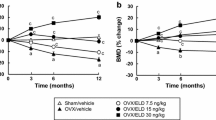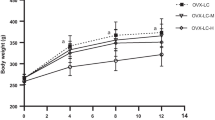Abstract.
Vitamin D metabolites can prevent estrogen depletion-induced bone loss in ovariectomized (OVX) rats. Our aim was to compare the bone-protective effects of 1α,25-dihydroxyvitamin D3 (1,25(OH)2D3), 1α,25-dihydroxyvitamin D2 (1,25(OH)2D2), 1α-hydroxyvitamin D3 (1α(OH)D3), and 1α-hydroxyvitamin D2 (1α(OH)D2) in OVX rats. 1α(OH)D3 and 1α(OH)D2 are thought to be activated in the liver to form 1,25(OH)2D3 and 1,25(OH)2D2, respectively. Forty-four 12-week-old female Fischer-344 rats were either OVX or sham-operated (SHAM). Groups of OVX rats (n = 7 each) received vehicle alone, 1,25(OH)2D3, 1,25(OH)2D2, 1α(OH)D3, or 1α(OH)D2, starting 2 weeks after surgery. All vitamin D metabolites were administered orally at a dose of 15 ng/day/rat. Urine and blood samples were collected 6, 9, 12, and 16 weeks after surgery. Serum samples were analyzed for total calcium and phosphate. Calcium, phosphate, creatinine, and free collagen cross-links (ELISA) were determined in urine. After tetracycline double labeling, the rats were sacrificed 16 weeks postsurgery, and the proximal tibiae and the first lumbar vertebrae were processed undecalcified for static and dynamic bone histomorphometry. 1,25(OH)2D3 and, to a slightly lesser extent, 1,25(OH)2D2 elevated vertebral cancellous bone mass in OVX rats to a level beyond that observed in SHAM animals, and both compounds increased serum calcium and urinary calcium excretion to similar extents. 1α(OH)D3 and 1α(OH)D2 resulted in a 64% and 84%, respectively, inhibition of ovariectomy-induced vertebral cancellous bone loss. In the proximal tibial metaphysis, all vitamin D metabolites tested could only partially prevent post-OVX trabecular bone loss, with a tendency for 1α(OH)D3 to be the least active compound. The effects of 1α(OH)D3 and 1α(OH)D2 on calcium homeostasis differed markedly, however. The mean increase in urinary calcium excretion over the whole experiment was fivefold for 1α(OH)D3, whereas the corresponding increase for 1α(OH)D2 was only twofold. We conclude that, compared with 1α(OH)D3, 1α(OH)D2 combined at least equal or higher bone-protective activity in OVX rats with distinctly less pronounced effects on calcium homeostasis. This effect was not due to a differential action of the corresponding main activation products, 1,25(OH)2D3 and 1,25(OH)2D2.
Similar content being viewed by others
Author information
Authors and Affiliations
Additional information
Received: 2 May 1996 / Accepted: 18 October 1996
Rights and permissions
About this article
Cite this article
Erben, R., Bante, U., Birner, H. et al. 1α-Hydroxyvitamin D2 Partially Dissociates Between Preservation of Cancellous Bone Mass and Effects on Calcium Homeostasis in Ovariectomized Rats. Calcif Tissue Int 60, 449–456 (1997). https://doi.org/10.1007/s002239900261
Published:
Issue Date:
DOI: https://doi.org/10.1007/s002239900261




